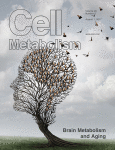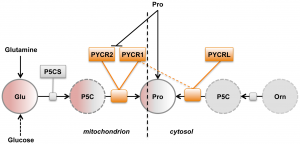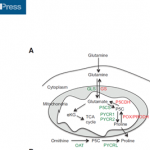 Last year, Boris Ratnikov was reading a paper and saw a familiar image.
Last year, Boris Ratnikov was reading a paper and saw a familiar image.
He quickly realized: The image was from a 2012 paper he’d written, but wasn’t cited. The 2016 Cell Metabolism paper he was reading had copied a figure from his 2012 PLOS ONE paper without referencing it.
In September 2016, Ratnikov, who is based at Sanford-Burnham-Prebys Medical Discovery Institute, in La Jolla, California, emailed an editor at Cell Metabolism to express his concern about the duplication and omitted citation.
Although the journal told us it “carefully investigated Dr Ratnikov’s concerns,” the editors ultimately did not think the literature needs correcting.
Does failing to cite a paper constitute plagiarism?
Ratnikov would say it does, though the journal would disagree. According to Ratnikov, the 2016 paper copied original materials from his 2012 PLOS ONE paper and thus “plagiarized our work by not citing it.”
The editors at Cell Metabolism, however, believe that the figure in question was meant as “a general overview,” rather than “an adaptation” of the figure from Ratnikov’s paper, and thus citing the 2012 paper was not necessary.
Here are the figures in question (click to enlarge; post continues below):

Figure 5. Model of proline biogenesis in melanoma. The cartoon presents a model that provides the simplest interpretation of the findings presented here. Sub-cellular localization and the roles of the three PYCRs in proline biosynthesis are shown. PYCR1 and PYCR2 are located in the mitochondria, and both have access to the pool of P5C generated from glutamate by P5CS. Under certain conditions (such as high concentration of ornithine and low proline in the medium) PYCR1 has access to a P5C pool generated in the cytoplasm (dotted line). In contrast, PYCRL primarily uses a cytosolic pool of P5C. Salvage of proline from extracellular sources is also shown as well as its inhibitory effects on PYCR1 and PYCR2. Abbreviations: Glutamate (Glu), Pyrroline-5-Carboxylate (P5C), Proline (Pro), Ornithine (Orn), Pyrroline-5-Carboxylate Reductase (PYCR), Pyrroline-5-Carboxylate Synthase (P5CS).

Figure 2. Increased Proline Biosynthesis Allows Proline-Independent Cells to Retain Clonogenicity upon Proline Starvation
(A) Schematic depiction of proline biosynthesis and catabolism pathways.
To cite or not to cite?
Forwarded email correspondences between Ratnikov, the journal, and the corresponding author on the Cell Metabolism paper, Jeffrey Settleman, provide further insights about what went on.
According to Ratnikov, the PLOS ONE paper, “Functional Specialization in Proline Biosynthesis of Melanoma,” published in September 2012, was the first to define and characterize a particular pathway that promotes tumor cell growth. Ratnikov and his co-authors depicted how that pathway works in Figure 5 of the paper. In the 2016 Cell Metabolism paper, “Proline Starvation Induces Unresolved ER Stress and Hinders mTORC1-Dependent Tumorigenesis,” the authors depicted the same pathway in Figure 2A.
In July 2017, Ratnikov also informed the journal:
Before I contacted Cell Metabolism with my inquiry I had consulted with the Office of intellectual property at our institution and they agreed that lack of referencing of our work in Dr. Settleman’s paper was a clear breach of scientific ethics and recommended I contacted Cell Metabolism to rectify the situation.
To rectify the situation, Ratnikov told us that Cell Metabolism could simply include a direct reference to the PLOS ONE paper where appropriate or the authors could modify “their figure 2A and the relevant text to exclude the information that can only be found in our work and not in the review article they used for citation.”
In October 2016, a senior editor at Cell Metabolism, Anne Granger, responded to Ratnikov’s initial complaint, explaining that “it may be hard at times to include all the relevant literature in a paper as space is limited.” The editor asked Ratnikov to contact the corresponding author of the Cell Metabolism paper, Settleman, to discuss the matter further.
In March 2017, Ratnikov contacted Settleman, a researcher at a biotech company in San Francisco, Calico Life Sciences, about the oversight. Settleman attempted to explain why he had not referenced Ratnikov’s article in his 2016 Cell Metabolism paper:
We are certainly aware of your study. As you have probably noticed, our publication was in the Short Article format for Cell Metabolism. As such, the number of references allowed is quite limited. In fact, our initial submission included many references that ultimately had to be excluded.
Settleman explained why Ratnikov’s article did not make the cut. Given the limited space for references, Settleman said that he and his co-authors decided to reference a review in Frontiers in Oncology, published in June 2012, which cites Ratnikov’s PLOS ONE study:
…we referenced a review article, which includes a citation that directs readers to the relevant work from your group. In my experience, this is very often how primary scientific findings are referenced.
The PLOS ONE paper has been cited 23 times, according to Clarivate Analytics’ Web of Science, and the work was supported by a grant from the National Institutes of Health. The Frontiers in Oncology review, “The proline regulatory axis and cancer,” has been cited 36 times.
A case of plagiarism?
When citing previous work, what’s appropriate? According to Miguel Roig, a professor of psychology at St. John’s University who has written about plagiarism and duplication in academic writing:
… that scenario would, in my view, probably constitute plagiarism (it always depends on the exact details of the case).
Roig — a member of the board of directors of our parent non-profit organization — explained:
In this type of case, the question for me is this: In writing a portion of a literature review, why would an author misappropriate material from the primary source to summarize that work, but then only cite the review article that describes the same work? I think the answer is obvious.
Roig added:
If an author copies verbatim, or even paraphrases/summarizes, from primary source A, that author has an ethical obligation to cite source A, period. The same applies if the author in question is writing about a novel idea described in source A. Even if no verbatim copying has taken place, source A must be credited with that idea. Citing only source B, which had also summarized A (and, presumably, cited it) misleads the reader as to the true source of the author’s material.
He also noted:
When writing literature reviews some authors may simultaneously rely on review articles, which may help the author place the work in question in a broader context, as well as on the primary work. In such cases, authors must cite both works as both served as sources for the author’s literature review.
“Matter closed”
In March, Ratnikov emailed the editors at Cell Metabolism again and on June 2, the senior editor, Granger, addressed Ratnikov’s concerns:
While we see where you are coming from, based on our evaluation of Figure 5 from your paper and figure 2A of their paper and our editorial discussions, our impression is that the Settleman figure was meant as a general overview of the entire proline biosynthesis pathway, rather than an adaptation of the figure from your paper. We also note that metabolic diagrams frequently bear some similarity to each other and are often embedded within figures in order to assist the reader as an overview. Although our preference at the journal is for citing the primary literature whenever possible, we feel that a reference to a review article which covers the different aspects of proline biosynthesis rather than several articles each covering individual aspects of the pathway is sufficient in this particular case.
Ratnikov quickly responded, again explaining that “the entire proline biosynthesis pathway was characterized in our paper and nowhere else.”
On June 26, Ratnikov received an email from the editor-in-chief of Cell Metabolism, Nikla Emambokus:
I have reviewed the figures from both Dr. Settleman’s and your PLoS One paper, “Functional specialization in proline biosynthesis of melanoma”, and discussed your conceptual concern with an external expert in the field, as well as our legal counsels. Based on our investigation, we do not see a case of publishing ethics infringement either on the part of Dr. Settleman or of Cell Metabolism.
Ratnikov responded the same day, asking for more information about the decision.Emambokus wrote back the next day:
We consider this matter closed.
Like Retraction Watch? Consider making a tax-deductible contribution to support our growth. You can also follow us on Twitter, like us on Facebook, add us to your RSS reader, sign up on our homepage for an email every time there’s a new post, or subscribe to our daily digest. Click here to review our Comments Policy. For a sneak peek at what we’re working on, click here.
Let me get this straight: You write paper A in which you copy a figure from paper B. You don’t think it’s necessary to cite paper B because you cite paper C that cites paper B. How on earth can anyone think this is this not plagiarism? Space restrictions are immaterial.
The figure in the new paper is not a “copy” by the standards of scientific publication. How can it NOT be relevant that the journal forced the authors to eliminate references to meet their “space” limitation. It is standard procedure, in such cases, for authors to replace references to individual papers with reference to review articles. The fault lies with the Journal and its antiquated policy.
I don’t think this constitutes plagiarism at all. Maybe RW should take a poll…
Am I missing something? I am looking at the two figures, and they do not look alike at all. It does not look like the Cell Metabolism figure is a copy of the PLoS One figure.
It is not a “carbon” copy but the entire biosynthesis part is.
From the Author Instructions / Information for Authors for Cell Metabolism, available at http://www.cell.com/cell-metabolism/authors :
“If you have adapted a figure from a published figure, please check with the copyright owners to see if permission is required and include a complete citation/reference for the original article.”
Nor do I understand the concern here; the images look entirely different to me. But, of course, I would have cited the original source.
Sometimes figures and tables are the central intellectual contribution of a paper. In such cases it is entirely reasonable to reproduce the figure or table in question, provided that citation is also included.
The figures are very different, even an adaptation appears far fetched.
This is clearly not plagiarism.
Make sure you actually study both figures. A bref glance is not sufficient.
I think the Cell Metabolism editor’s quoted correspondence is persuasive that this was doubtfully plagiarism. It was however poor citation practice fostered by the journal’s strictures for the article type. A short article format with rules on numbers of citations encourages citing review articles instead of the primary sources. Indeed don’t want a 3-page article to have a full page of citations, and readers don’t want to wade through them all, but for example, other sources could be listed in SI. That might help plagiarism concerns but doesn’t help with citation credit. In my world, when grovelling for funding, citations to previous related work is often invoked as a measure of how important the work is to the broader community.
Well cited work -> broad impacts -> better funding prospects. Poorly cited work -> esoteric pet project -> no funding. Ignoring the accuracy losses of secondary citations, citing reviews in lieu of primary sources deprives the original authors of that endorsement. It wouldn’t matter for citing old, dead authors but for contemporary authors it matters. Mariana Teixeira and others write more:
Teixeira, M.C., et al. 2013. Incorrect Citations Give Unfair Credit to Review Authors in Ecology Journals. PLoS ONE. 8(12): e81871. http://dx.doi.org/10.1371/journal.pone.0081871
Chris, I think your analysis is right on target. As such, it is regrettable that the editors did not correct the record. BTW, thanks for calling attention to the Teixeira et al paper.
If you take someone’s short paragraph that expresses a unique idea or concept and completely paraphrase/summarize it such that the new material uses different words and expressions, your paraphrase must cite the source of the original material, period. I hope there is no question about this. Well, similarly, if you take someone else’s image that expresses a unique concept or process, completely redraw it such that your new image is different but yet conveys the original concept, you still must also cite the source. The same basic principle applies.
The figures are a red herring – they are only similar in the same way that any diagram of the Krebs cycle (say) will convey the same information. The issue here is when group A discovers a pathway, and then group B publicises that discovery in a review – is it acceptable for group C to cite B as a source rather than A?
This is not always an easy question. Obviously original sources should be cited where appropriate, but what is the statute of limitations? When has knowledge become sufficiently widespread that a reference to a review is adequate? Four years seems too short, yet at some point there must be a cutoff. I’m a molecular geneticist, and so in principle I could (should?) cite Watson and Crick (1953) and Saiki et al (1988) in every paper I write, yet I don’t.
This is the problem of ‘common knowledge’. At what point is a concept so well-known that mentioning or discussing it in a paper does not require a citation because there is an assumption that everyone knows about it (i.e., common knowledge)? In some cases, the need for a citation may depend on the context in which the work is being disseminated and the assumed knowledge of the readers. Indeed, there may be situations where the need to cite comes down to a judgement call. This case does not strike me as being one of those.
The problem would be easy to solve. Unfortunately, for typographic or other reasons, journals do not allow to put gigantic quotation marks around figures and tables.
The copyright issues are another thing, but these are mostly outside of the scope of academia and science, and, hence, uninteresting as such (a.k.a. the famous IANAL abbrevation).
Every figure in a Scientific paper includes a figure caption and it SOP cite original sources for the information in the figure in that caption. No “gigantic quotes” are needed.
I personally agree with your comment entirely.
However, as seen also in the comments to this post, there seems to be genuine confusion on how to replicate (cf. “direct quotation”), reproduce (cf. “redraw a figure or table”), cite, and reference figures and tables. The practices of using the word “adopted” (or related words) are ever so confusing, varying from a field to another.
The answer is as clear as can be: you use it, you cite it!
I also don’t think that there is anything wrong here. The scheme in the Cell Stem Cell paper looks more complex with additional elements to the pathway. In case of short reports, there are limitations in citation numbers and very often overview is given by citing reviews which in this case may have had a more broader view with the additional players involved (additionally the Plosone paper explicitly states `in melanoma` in the title).
I think you are failing to see the forest behind the trees. Their figure is a composite that uses mine as a component and a significant one. Putting other people’s figures or findings together in a composite does not absolve of responsibility to cite each one individually, otherwise it looks like it was derived independently.
This is why it is so important to look at original paper especially if it’s only 4 years earlier.